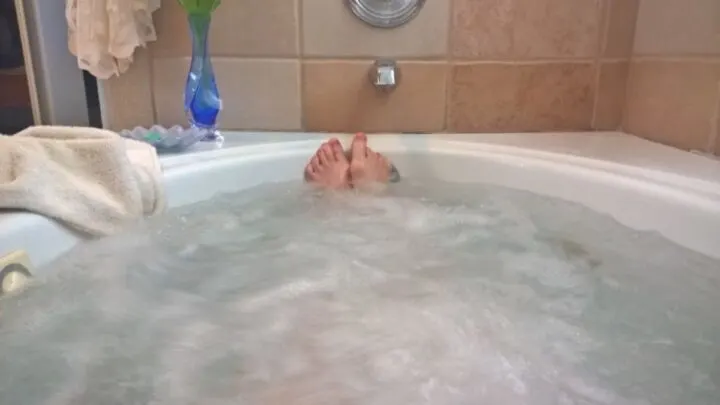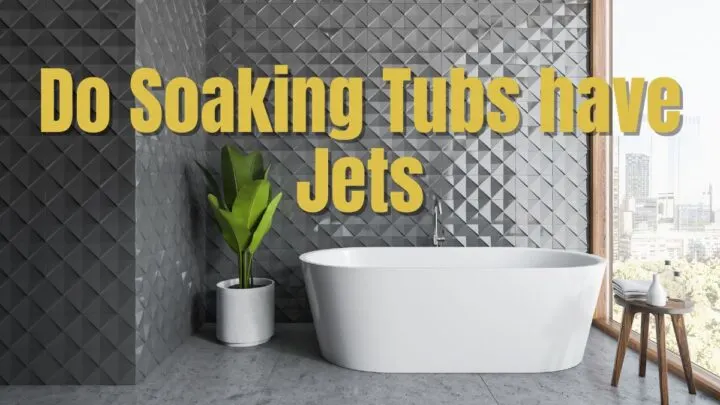Soaking tubs have become more and more popular recently, as they are seen as a luxury in many homes. But do they have jets?
Many people are used to hot tubs or pools having jets, so it would make sense that soaking tubs might have them too, right?
As a general rule of thumb, soaking tubs don’t have jets. However, soaking tubs may have other features to replicate the jet experience through whirlpools, artificial wave creators, and other air features that create moving water in the tub.
The primary difference between soaking tubs and your average household bathtub is the quantity of water each can contain. A general bathtub holds a maximum of 40 gallons of water, while a soaking tub of a larger size can contain above 200 gallons of water.
A soaking tub can best be described as a mini-pool and can come with heating features similar to a pool.
However, it is fundamentally different from a jetted pool, better known as a jacuzzi, which can be constructed like a fixed or portable hot tub and creates jets in the water for a relaxing, therapeutic experience.
While the original Jacuzzi jets were installed in bathtubs, it’s very rarely the case that a soaking tub will have jets as features.
Table of Contents
Take your bathroom to the next level with a stunning and relaxing tub. Read our guide to explore the different sizes, shapes, and materials available for soaking tubs.
The Differences and Similarities Between Soaking Tubs and Jetted Tubs
Soaking Tubs
These are characterized as standard bathtubs but are deeper on average than a regular bathtub.
Soaking tubs are circular and shorter in length than bathtubs, which are more often rectangular and elongated.
Instead of the person taking the bath soaking length-wise, the depth of the soaking tub is in the width, so the entire body is covered width-wise, standing up in the tub.
Soaking tubs are all the rage in smaller, modern houses since they can fit easily into most bathroom spaces.
Bathrooms on the ground floors of houses can easily accommodate soaking tubs since the floor can be dug out, and a deep tub can be fitted in.
Most soaking tubs are equipped with heating features, can be adapted structurally to most bathrooms, and are created using most bathroom construction materials in many colors and styles.

Jetted Tub
Unlike a soaking tub, not every household can adapt to the features required to operate a jetted tub.
Called “whirlpools” more commonly than jetted tubs, these are similar in construction to a soaking tub but aren’t necessarily as deep or adaptable to bathroom spaces as soaking tubs.
These are also, on average, more expensive to get fitted in bathrooms, saunas, or spas, given their high installation and maintenance costs.
Types of Jetted Tubs
Jetted tubs come in 2 standard types. The first uses a system that shoots water through the jets to heat it, which helps elongate the time the water remains warm.
The re-circulation of water through the jets also performs a therapeutic function.
For most jetted tubs of this kind, bubble baths, salts, and shower oils aren’t recommended since they can clog the jet system.
The second kind of jet system uses air to create waves and jets instead of a re-filtration system that jets out water.
This kind of tub creates less potent waves than water jets and can be used with bath salts and oils with ease.
Types of Soaking Tubs
Some common types of soaking tubs are corner, overmount, freestanding, under-mount, alcove, Japanese, and walk-in.
Corner tubs can be designed to fit into congested, square spaces and are all the rage with rectangular, compact, modern homes.
Overmount soaking tubs are fixed into a cavity dug into your floor with the rim around the top of the tub visible, while under mount tubs are installed above the floor or in a decked space.
Most commonly found in luxury homes and much-loved by interior designers, alcove soaking tubs are surrounded by 3 walls and are in an area separate from the toilet with shower systems.
Japanese soaking tubs are characterized by depths, and even drastically tall people can stand in these soaking tubs lengthwise without needing to squat.
Walk-in soaking tubs have a door for entry and exit and are very similarly constructed to pool stairs on the side of the tub. These require a large space for installation.
To Conclude – Which Is Better, Soaking Tubs or Jetted Tubs?
Depending on your budget and the adaptability of the tub structure to your house, both soaking tubs and jetted tubs have their advantages.
Soaking tubs can offer you a long, peaceful bath in a deep, pool-like tub where leg cramps won’t plague you, and water will remain warmer for longer times, given its sheer capacity.
Jetted tubs imitate wave patterns that serve a therapeutic function, but you can’t always use bath oils and salts lest you clog up the drainage and jet systems.
Depending on these features, the choice is yours since both are relaxing and improve your bath time substantially.
In conclusion, most soaking tubs are not equipped with jets but have other options available.
If you found this article helpful and would like to learn more about soaking tubs, make sure to take a look at the related posts below!


